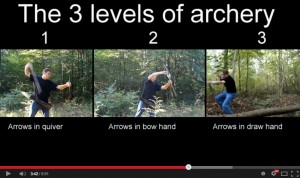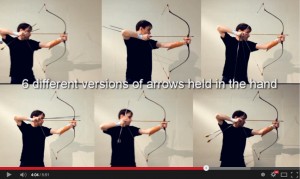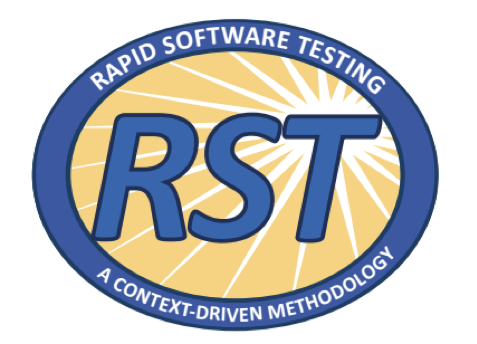Yesterday I saw this awesome video of Lars Andersen: a new level of archery. It is going viral on the web being watched over 11 million times within 48 hours. Now watch this movie carefully…
The first time I watched this movie, I was impressed. Having tried archery several times, I know how hard it is to do. Remember Legolas from the Lord of Rings movie? I thought that was “only” a movie and his shooting speed was greatly exaggerated. But it turns out Lars Andersen is faster than Legolas. My colleague Sander send me an email telling me about the movie I just watched saying this was an excellent example of craftsmanship, something we have been discussing earlier this week. So I watched the movie again…
Also read what Lars has to say in the comments on YouTube and make sure you read his press release.
This movie is exemplar for the importance of practice and skills! This movie explains archery in a way a context-driven tester would explain his testing…
0:06 These skills have been long since been forgotten. But master archer Lars Andersen is trying to reinvent was has been lost…
Skills are the backbone of everything being done well. So in testing skills are essential too. I’ll come back to that later on. And the word reinvent triggers me as well. Every tester should reinvent his own testing. Only by going very deep, understand every single bit, practice and practice more, you will truly know how to be an excellent tester.
0:32 This is the best type of shooting and there is nothing beyond it in power or accuracy. Using this technique Larsen set several speed shooting records and he shoots more than twice as fast as his closest competitors…
Excellent testers are faster and better. Last week I heard professor Chris Verhoef speak about skills in IT and he mentioned that he has seen a factor 200 in productivity difference between excellent programmers and bad programmers (he called them “Timber Smurf” or “Knutselsmurf” in Dutch).
0:42 … being able to shoot fast is only one of the benefits of the method
Faster testing! Isn’t that what we are after?
0:55 Surprisingly the quiver turned out to be useless when it comes to moving fast. The back quiver was a Hollywood Myth…
The back quiver is a Hollywood myth. It looks cool and may look handy on first sight, since you can put a lot of arrows in it. Doesn’t this sound like certificates and document-heavy test approaches? The certificates looks good on your resume and the artifacts look convenient to help you structure your testing… But turn out to be worthless when it comes to test fast.
1:03 Why? Because modern archers do not move. They stand still firing at a target board.
I see a parallel here with old school testing: testers had a lot of time to prepare in the waterfall projects. The basic assumption was that target wasn’t moving, so it was like shooting at a target board. Although the target proved always to be moving, the testing methods are designed for target boards.
1:27 Placing the arrow left around the bow is not good while you are in motion. By placing your hand on the left side, your hand is on the wrong side of the string. So you need several movements before you can actually shoot..
Making a ton of documentation before starting to test is like several movements before you can actually test.
1:35 From studying old pictures of archers, Lars discovered that some historical archers held their arrow on the right side of the bow. This means that the arrow can be fired in one single motion. Both faster and better!
Research and study is what is lacking in testing for many. There is much we can learn from the past, but also from social science, measurement, designing experiments, etc.
1:56 If he wanted to learn to shoot like the master archers of old, he had to unlearn what he had learned…
Learning new stuff, learning how to use heuristics and train real skills, needs testers to unlearn APPLYING techniques.
2:07: When archery was simpler and more natural, exactly like throwing a ball. In essence making archery as simple as possible. It’s harder how to learn to shoot this way, but it gives more options and ultimately it is also more fun.
It is hard to learn and it takes a lot of practice to learn to do stuff in the most efficient en effective way. Context-driven testing sounds difficult, but in essence it makes testing as simple as possible. That means it becomes harder to learn because it removes all the methodical stuff that slows us down. These instrumental approaches trying to put everything in a recipe so it can be applied by people who do not want to practice, make testing slow and ineffective.
2:21 A war archer must have total control over his bow in all situations! He must be able to handle his bow and arrows in a controlled way, under the most varied of circumstances.
Lesson 272 in the book Lessons Learned in Software Testing: “If you can get a black belt in only two weeks, avoid fights”. You have to learn and practice a lot to have total control! That is what we mean by excellent testing: being able to do testing in a controlled way, under the most varied of circumstances. Doesn’t that sound like Rapid Software Testing? RST is the skill of testing any software, any time, under any conditions, such that your work stands up to scrutiny. This is how RST differs from normal software testing.
2:36 … master archers can shoot the bow with both hands. And still hit the target. So he began practicing…
Being able to do the same thing in different ways is a big advantage. Also in testing we should learn to test in as many different ways as possible.
3:15 perhaps more importantly: modern slow archery has led people to believe that war archers only shot at long distances. However, Lars found that they can shoot at any distance. Even up close. This does require the ability to fire fast though.
Modern slow testing has led to believe that professional testers always need test cases. However, some testers found that they could work without heavyweight test documentation and test cases. Even on very complex or critical systems also in a regulated environment. This does require the ability to test fast though.
 3:34 In the beginning archers probably drew arrows from quivers or belts. But since then they started holding the arrows in the bow hand. And later in the draw hand. Taking it to this third level. That of holding the arrows in the bow hand, requires immense practice and skill and only professional archers, hunters and so on would have had the time for it. … and the only reason Lars is able to do it, is he has been years of practicing intensely.
3:34 In the beginning archers probably drew arrows from quivers or belts. But since then they started holding the arrows in the bow hand. And later in the draw hand. Taking it to this third level. That of holding the arrows in the bow hand, requires immense practice and skill and only professional archers, hunters and so on would have had the time for it. … and the only reason Lars is able to do it, is he has been years of practicing intensely.
Practice, practice, practice. And this really makes the difference. I hear people say that context-driven is not for everybody. We have to accept that some testing professional only want to work 9 to 5. This makes me mad!
I think professional excellence can and should be for everyone! And sure you need to put a lot of work in it! Compare it to football (or any other good thing you want to be in like solving crossword puzzles, drawing, chess or … archery). It takes a lot of practice to play football in the Premiership or the Champions League. I am convinced that anyone can be a professional football player. But it doesn’t come easily. It demands a lot of effort in learning, drive (intrinsic motivation, passion), the right mindset and choosing the right mentors/teachers. Talent maybe helps, and perhaps you need some talent to be the very best, like Lionel Messie … But dedication, learning and practice will take you a long way. We are professionals! So that subset of testers who do not want to practice and work hard, in football they will soon end up on the bench, won’t get a new contract and soon disappear to the amateurs.
 4:06 The hard part is not how to hold the arrows, but learning how to handle them properly. And draw and fire in one single motion not matter what methods is used.
4:06 The hard part is not how to hold the arrows, but learning how to handle them properly. And draw and fire in one single motion not matter what methods is used.
Diversity has been key in context-driven testing for many years. As testers we need to learn how to properly use many different skills, approaches, techniques, heuristics…
4:12 It works in all positions and while in motion…
… so we can use then in all situations even when we are under great pressure, we have to deal with huge complexity, confusion, changes, new insights and half answers.
5:17 While speed is important, hitting the target is essential.
Fast testing is great, doing the right thing, like hitting the target is essential. Context-driven testers know how to analyze and model their context to determine what the problem is that needs to be solved. Knowing the context is essential to do the right things to discover the status of the product and any threats to its value effectively, so that ultimately our clients can make informed decisions about it. Context analysis and modelling are some of the essential skills for testers!
There are probably more parallels to testing. Please let me know if you see any more.
”Many people have accused me of being fake or have theories on how there’s cheating involved. I’ve always found it fascinating how human it is, to want to disbelieve anything that goes against our world view – even when it’s about something as relatively neutral as archery.” (Lars Andersen)



Recent Comments